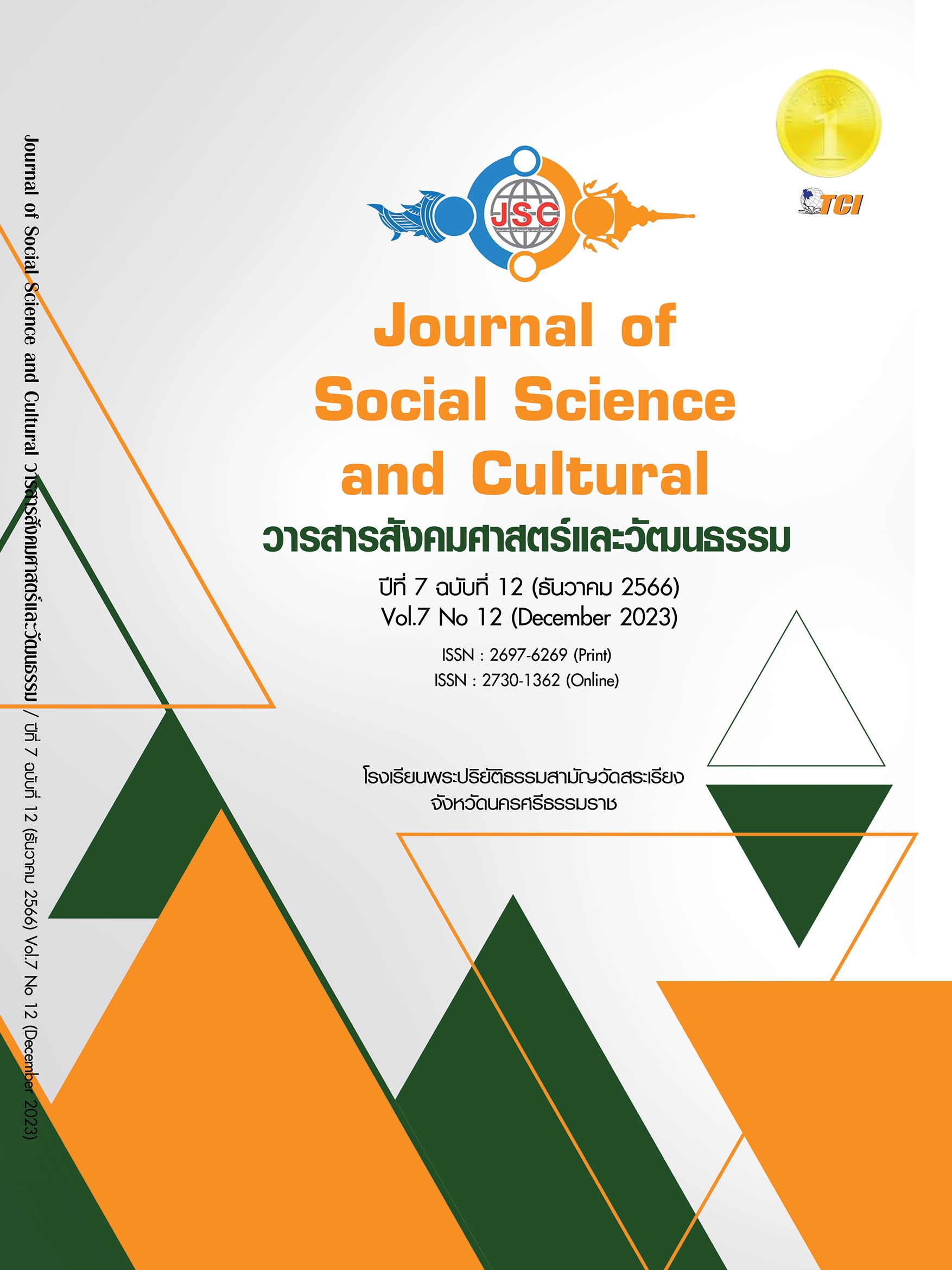THE ROLES OF BUDDHIST MANTRA IN THE PRACTICE OF HOLY WATER: A CASE STUDY OF RATANA SUTTA CHANT DURING THE COVID - 19 PANDEMIC
Main Article Content
Abstract
This research article aims to study the roles of Buddhist mantras in making holy water by chanting the Ratana Sutta during the outbreak of the COVID - 19 virus disease. Using the concept of Functionalism. Used to study folklore information regarding roles and responsibilities in society. The researcher therefore used it to analyze the role of Buddhist mantras resulting from the chanting of the Rattana Sutta to make holy water during COVID - 19. During the chanting of the Rattana Sutta, holy water will be made. Content scope to study and collect information from 1) primary documents include: the Tripitaka edition of Mahachulalongkornrajavidyalaya University 2) secondary documents include: research, articles, books and 3) online media information that contains references to chanting the Rattana Sutta and making holy water. This research is a qualitative study that relies on data from relevant documents related to the Ratana Sutta, the beliefs of Buddhist mantra by Ratana Sutta chant, and the practice of the holy water using Ratana Sutta chant according to the guidelines of the Sangha Supreme Council published on March 25, 2020. The research findings, analyzed through content analysis, reveal that the roles of Buddhist mantra derived from the recitation of Ratana Sutta during COVID - 19 are characterized by three important roles that are 1) cause faith 2) encouraging human confidence, and 3) emphasizing the significance of Buddhism in Thai society during a crisis. Ratana Sutta Chanting and Ratana Sutta holy water plays an effective role to support human spirits especially in the times of crisis. Interestingly, they are also applied to deal with the emergence of COVID - 19 pandemic in Thai society.
Article Details
References
ไทยโพสต์ออนไลน์. (2563). น้ำมนต์ไล่โควิด! 'ทีมจิตอาสาจันทบูร' ผสมน้ำมนต์กับยาฆ่าเชื้อให้พระฉีดพ่นในงานทำบุญ 100 วัน. เรียกใช้เมื่อ 25 มีนาคม 2565 จาก https://www.thaipost.net/main/detail/61277
ธีรโชติ เกิดแก้ว. (2563). การปรับตัวและการร่วมมือในสถานการณ์โควิด 19 ตามแนวพุทธศาสน์. วารสารบัณฑิตศึกษาปริทรรศน์, 16(2), 59-78.
ผู้จัดการออนไลน์. (2563). สาธุ!เจ้าคณะจังหวัดเสกน้ำมนต์พ่นไล่เชื้อร้ายโควิด - 19 พ้นเมืองมหาสารคาม. เรียกใช้เมื่อ 25 มีนาคม 2565 จาก https://mgronline.com/local/detail/9630000037591
พระครูโอภาสธรรมพิทักษ์ (เสียม เตชธมฺโม). (2559). พัฒนาการรูปแบบการสวดมนต์ในสังคมไทยปัจจุบัน. วารสาร มจร พุทธปัญญาปริทรรศน์, 1(1), 23-36.
พระมหาโกมล กมโล และคณะ. (2561). ศึกษาวิเคราะห์บทบาลีในรตนสูตร ตามแนวคัมภีร์สัททาวิเสส. วารสารบัณฑิตศึกษาปริทรรศน์, 14(2), 43-54.
พระมหาประทีป สญฺญโม(พรมสิทธิ) และโสวิทย์ บำรุงภักดิ์. (2560). การศึกษาการบำบัดโรคด้วยการเจริญพระพุทธมนต์ในเชิงพัฒนาการ. วารสารวิชาการธรรมทรรศน์, 17(3), 403-414.
พระมหาปริญญา วรญาโน. (2564). การศึกษาวิเคราะห์การบรรเทาภัยพิบัติด้วยรัตนสูตร. วารสารเสฏฐวิทย์ปริทัศน์, 1(3), 47-60.
ลิขิต ลิขิตานนท์. (2534). วรรณกรรมพุทธศาสนาเถรวาท. เชียงใหม่: ภาควิชาภาษาไทย คณะมนุษยศาสตร์ มหาวิทยาลัยเชียงใหม่.
วัดจันทาราม (ท่าซุง). (2565). รัตนสูตร (บท "ยังกิญจิ" ทำน้ำมนต์) สวดเพื่อปัดเป่าอุปัทวันตรายให้หมดไป (VEDIO - MP3). เรียกใช้เมื่อ 25 มกราคม 2565 จาก http://www.watthasung.com/wat/ viewthread.php?tid=829
ศิริพร ณ ถลาง. (2557). ทฤษฎีคติชนวิทยา: วิธีวิทยาในการวิเคราะห์ตำนาน - นิทานพื้นบ้าน. กรุงเทพมหานคร : สำนักพิมพ์แห่งจุฬาลงกรณ์มหาวิทยาลัย.
สำนักเลขาธิการมหาเถรสมาคม, สำนักงานพระพุทธศาสนาแห่งชาติ. (2563). มติมหาเถรสมาคม. เรียกใช้เมื่อ 21 มกราคม 2565 จาก https://ssc.onab.go.th/th/page/item/index/id/13
สำนักเลขาธิการมหาเถรสมาคม, สำนักงานพระพุทธศาสนาแห่งชาติ. (2564). มติมหาเถรสมาคม. เรียกใช้เมื่อ 25 มกราคม 2565 จาก https://ssc.onab.go.th/th/page/item/index/id/13
สุชาติ บุษย์ชญานนท์. (2561). ความเชื่อเรื่องน้ำมนต์สำหรับพุทธศาสนิกชน. วารสารวนัมฎองแหรกพุทธศาสตรปริทรรศน์, 5(1), 25-39.


